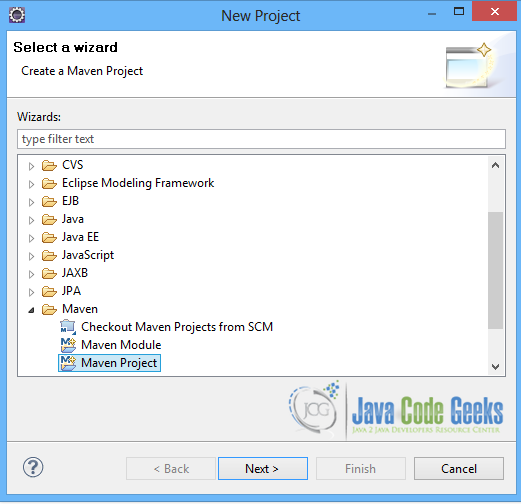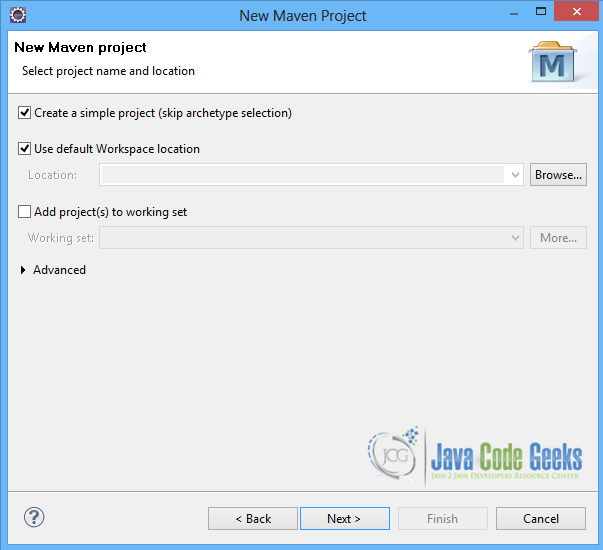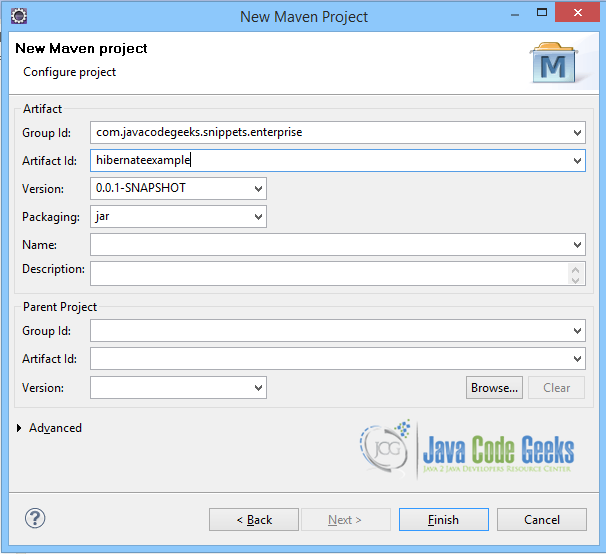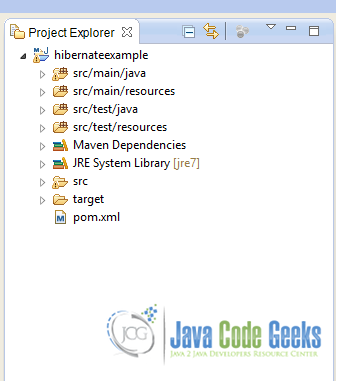Hibernate JPA DAO Example
This is an example of how to create Data Access Objects (DAOs), making use of the Hibernate implementation for the Java Persistence API (JPA) specification. Hibernate is an object-relational mapping library for Java, that provides a framework for mapping an object-oriented domain model to a traditional relational database.
When an application interacts with a database, it is common pattern to separate all the low level data access operations from high level business services. This can be achieved using DAOs, which are objects that provide abstract interfaces to the database. DAOs may be used from services in higher layers of the application, thus connecting a service layer and the database.
Below, we will create a DAO class (Data Access Layer) and will call its interface in another class (Service Layer) to create, read, update and delete rows (CRUD operations) from a database table.
You may skip project creation and jump directly to the beginning of the example below.
Our preferred development environment is Eclipse. We are using Eclipse Juno (4.2) version, along with Maven Integration plugin version 3.1.0. You can download Eclipse from here and Maven Plugin for Eclipse from here. The installation of Maven plugin for Eclipse is out of the scope of this tutorial and will not be discussed. We are also using the JDK 7_u_21. The Hibernate version is 4.3.6, and the database used in the example is MySQL Database Server 5.6.
Let’s begin:
1. Create a new Maven project
Go to File -> Project ->Maven -> Maven Project.

In the “Select project name and location” page of the wizard, make sure that “Create a simple project (skip archetype selection)” option is checked, hit “Next” to continue with default values.
In the “Enter an artifact id” page of the wizard, you can define the name and main package of your project. We will set the “Group Id” variable to "com.javacodegeeks.snippets.enterprise" and the “Artifact Id” variable to "hibernateexample". The aforementioned selections compose the main project package as "com.javacodegeeks.snippets.enterprise.hibernateexample" and the project name as "hibernateexample". Hit “Finish” to exit the wizard and to create your project.
The Maven project structure is shown below:
- It consists of the following folders:
- /src/main/java folder, that contains source files for the dynamic content of the application,
- /src/test/java folder contains all source files for unit tests,
- /src/main/resources folder contains configurations files,
- /target folder contains the compiled and packaged deliverables,
- the pom.xml is the project object model (POM) file. The single file that contains all project related configuration.
2. Add hibernate 4.3.6 dependency
You can add all the necessary dependencies in Maven’s pom.xml file, by editing it at the “Pom.xml” page of the POM editor. Apart from hibernate dependency, we will also need the mysql-connector-java package.
pom.xml:
<project xmlns="http://maven.apache.org/POM/4.0.0" xmlns:xsi="http://www.w3.org/2001/XMLSchema-instance" xsi:schemaLocation="http://maven.apache.org/POM/4.0.0 http://maven.apache.org/xsd/maven-4.0.0.xsd"> <modelVersion>4.0.0</modelVersion> <groupId>com.javacodegeeks.snippets.enterprise</groupId> <artifactId>hibernateexample</artifactId> <version>0.0.1-SNAPSHOT</version> <dependencies> <dependency> <groupId>org.hibernate</groupId> <artifactId>hibernate-core</artifactId> <version>4.3.6.Final</version> </dependency> <dependency> <groupId>mysql</groupId> <artifactId>mysql-connector-java</artifactId> <version>5.1.6</version> </dependency> </dependencies> </project>
As you can see Maven manages library dependencies declaratively. A local repository is created (by default under {user_home}/.m2 folder) and all required libraries are downloaded and placed there from public repositories. Furthermore intra – library dependencies are automatically resolved and manipulated.
3. Create the entity class
Book.java class is the entity class which uses some basic Hibernate JPA annotations to be mapped to BOOK table in the database.
Book.java
package com.javacodegeeks.snippets.enterprise.hibernate.model;
import javax.persistence.Column;
import javax.persistence.Entity;
import javax.persistence.Id;
import javax.persistence.Table;
@Entity
@Table(name = "book")
public class Book {
@Id
@Column(name = "id")
private String id;
@Column(name = "title")
private String title;
@Column(name= "author")
String author;
public Book() {
}
public Book(String id, String title, String author) {
this.id = id;
this.title = title;
this.author = author;
}
public Book(String title, String author) {
this.title = title;
this.author = author;
}
public String getId() {
return id;
}
public void setId(String id) {
this.id = id;
}
public String getTitle() {
return title;
}
public void setTitle(String title) {
this.title = title;
}
public String getAuthor() {
return author;
}
public void setAuthor(String author) {
this.author = author;
}
@Override
public String toString() {
return "Book: " + this.id + ", " + this.title + ", " + this.author;
}
}
4. Create the DAO class
BookDao.java class is the Dao class, which contains all the basic CRUD methods to interact with the database.
First of all, getSessionFactory() is a static method that provides a SessionFactory, the creator of Sessions, the basic interfaces between a Java application and Hibernate. The SessionFactory is built with the StandardServiceRegistryBuilder, making use of Configuration. The Configuration is where we can specify properties and mapping documents to be used when creating a SessionFactory.
So, every method that interacts with the database gets a Session, making use of the getSessionFactory().
Two basic methods are used to get a Session from the SessionFactory, the openCurrentSession() and openCurrentSessionwithTransaction(). Both methods use the openSession() API method of SessionFactory. But the second one also opens a new transaction, making use of the beginTransaction() API method of Session.
Two basic methods are also used to close the Session, the closeCurrentSession and closeCurrentSessionwithTransaction(). Both methods use the session.close() API method of Session to close the Session, but the second method first commits the transaction, using getTransaction().commit() API method.
The basic CRUD methods to interact with a database are Create, Read, Update and Delete.
Create is done in persist(Book entity) method, with save(Object object) API method of Session, that persists an entity to the database.
Read is performed both in findById(String id) and in findAll() methods. findById method uses get(Class theClass, Serializable id) API method of Session to retrieve an object by its id, whereas findAll creates a new Query with a String SQL query, to get all rows of the table in a list.
Update is easily done in update(Book entity) method that uses update(Object object) API method of Session.
Delete is performed in delete(Book entity) and deleteAll() methods, using the findById(String id) and findAll() methods respectively to retrieve the objects from the database and then using delete(Object object) API method of Session.
BookDao.java
package com.javacodegeeks.snippets.enterprise.hibernate.dao;
import java.util.List;
import org.hibernate.Session;
import org.hibernate.SessionFactory;
import org.hibernate.Transaction;
import org.hibernate.boot.registry.StandardServiceRegistryBuilder;
import org.hibernate.cfg.Configuration;
import com.javacodegeeks.snippets.enterprise.hibernate.model.Book;
public class BookDao implements BookDaoInterface<Book, String> {
private Session currentSession;
private Transaction currentTransaction;
public BookDao() {
}
public Session openCurrentSession() {
currentSession = getSessionFactory().openSession();
return currentSession;
}
public Session openCurrentSessionwithTransaction() {
currentSession = getSessionFactory().openSession();
currentTransaction = currentSession.beginTransaction();
return currentSession;
}
public void closeCurrentSession() {
currentSession.close();
}
public void closeCurrentSessionwithTransaction() {
currentTransaction.commit();
currentSession.close();
}
private static SessionFactory getSessionFactory() {
Configuration configuration = new Configuration().configure();
StandardServiceRegistryBuilder builder = new StandardServiceRegistryBuilder()
.applySettings(configuration.getProperties());
SessionFactory sessionFactory = configuration.buildSessionFactory(builder.build());
return sessionFactory;
}
public Session getCurrentSession() {
return currentSession;
}
public void setCurrentSession(Session currentSession) {
this.currentSession = currentSession;
}
public Transaction getCurrentTransaction() {
return currentTransaction;
}
public void setCurrentTransaction(Transaction currentTransaction) {
this.currentTransaction = currentTransaction;
}
public void persist(Book entity) {
getCurrentSession().save(entity);
}
public void update(Book entity) {
getCurrentSession().update(entity);
}
public Book findById(String id) {
Book book = (Book) getCurrentSession().get(Book.class, id);
return book;
}
public void delete(Book entity) {
getCurrentSession().delete(entity);
}
@SuppressWarnings("unchecked")
public List<Book> findAll() {
List<Book> books = (List<Book>) getCurrentSession().createQuery("from Book").list();
return books;
}
public void deleteAll() {
List<Book> entityList = findAll();
for (Book entity : entityList) {
delete(entity);
}
}
}
Below is the DAO interface that contains all methods that we want to be exposed in the Service layer.
BookDaoInterface.java
package com.javacodegeeks.snippets.enterprise.hibernate.dao;
import java.io.Serializable;
import java.util.List;
public interface BookDaoInterface<T, Id extends Serializable> {
public void persist(T entity);
public void update(T entity);
public T findById(Id id);
public void delete(T entity);
public List<T> findAll();
public void deleteAll();
}
5. Create the Service class
BookService.java class is the service which makes use of the DAO object to interact with the database. The DAO object is a static field in the service, initialized in the service constructor. So, when a new service instance is created, a new DAO instance will also be created.
In each one of the service methods, the bookDao object is used to open/close a session or a session with transaction, and to perform each one of the CRUD actions described above. In this layer all the transactions are handled. For example, persist, update and delete methods must follow the openSessionWithTransaction() method, whereas, findById and findAll methods only need the openSession() method.
BookService.java
package com.javacodegeeks.snippets.enterprise.hibernate.service;
import java.util.List;
import com.javacodegeeks.snippets.enterprise.hibernate.dao.BookDao;
import com.javacodegeeks.snippets.enterprise.hibernate.model.Book;
public class BookService {
private static BookDao bookDao;
public BookService() {
bookDao = new BookDao();
}
public void persist(Book entity) {
bookDao.openCurrentSessionwithTransaction();
bookDao.persist(entity);
bookDao.closeCurrentSessionwithTransaction();
}
public void update(Book entity) {
bookDao.openCurrentSessionwithTransaction();
bookDao.update(entity);
bookDao.closeCurrentSessionwithTransaction();
}
public Book findById(String id) {
bookDao.openCurrentSession();
Book book = bookDao.findById(id);
bookDao.closeCurrentSession();
return book;
}
public void delete(String id) {
bookDao.openCurrentSessionwithTransaction();
Book book = bookDao.findById(id);
bookDao.delete(book);
bookDao.closeCurrentSessionwithTransaction();
}
public List<Book> findAll() {
bookDao.openCurrentSession();
List<Book> books = bookDao.findAll();
bookDao.closeCurrentSession();
return books;
}
public void deleteAll() {
bookDao.openCurrentSessionwithTransaction();
bookDao.deleteAll();
bookDao.closeCurrentSessionwithTransaction();
}
public BookDao bookDao() {
return bookDao;
}
}
6. Configure hibernate
The hibernate.cfg.xml file shown below is where all configuration needed for the interaction with the database is set. The database that is used is defined here, as well as the database user credentials. The dialect is set to MySQL, and the driver is the com.mysql.jdbc.Driver. There is also a mapping attribute, where the entity class is defined.
You can also set specific database options here, such as whether the schema will be created or just updated, every time the sessionFactory is created. This is configured in the hibernate.hbm2ddl.auto property, which is set to update. So the schema is only updated. If this property is set to create, then every time we run our application, the schema will be re-created, thus deleting previous data. Another property set here is the show_sql, which specifies whether the sql queries will be shown in the console or the logger. Finally, the hibernate.current_session_context_class is set to thread, meaning that the SessionFactory will bind the Session to the thread from which openSession() method is called.
hibernate.cfg.xml
<?xml version="1.0" encoding="utf-8"?> <!DOCTYPE hibernate-configuration SYSTEM "http://www.hibernate.org/dtd/hibernate-configuration-3.0.dtd"> <hibernate-configuration> <session-factory> <property name="hibernate.dialect">org.hibernate.dialect.MySQLDialect</property> <property name="hibernate.connection.driver_class">com.mysql.jdbc.Driver</property> <property name="hibernate.connection.url">jdbc:mysql://localhost/library</property> <property name="hibernate.connection.username">root</property> <property name="hibernate.connection.password">root</property> <property name="hibernate.hbm2ddl.auto">update</property> <property name="show_sql">false</property> <property name="hibernate.current_session_context_class">thread</property> <mapping class="com.javacodegeeks.snippets.enterprise.hibernate.model.Book"/> </session-factory> </hibernate-configuration>
7. Run the Application
In order to run the example, first create a library database and add a book table, using the SQL statement below:
Create Book table statement
CREATE TABLE `library`.`book` ( id VARCHAR(50) NOT NULL, title VARCHAR(20) default NULL, author VARCHAR(50) default NULL, PRIMARY KEY (id) );
Then, run the following application. It creates a new BookService instance, which also creates its own bookDao instance to interact with the database.
App.java
package com.javacodegeeks.snippets.enterprise.hibernate;
import java.util.List;
import com.javacodegeeks.snippets.enterprise.hibernate.model.Book;
import com.javacodegeeks.snippets.enterprise.hibernate.service.BookService;
public class App {
public static void main(String[] args) {
BookService bookService = new BookService();
Book book1 = new Book("1", "The Brothers Karamazov", "Fyodor Dostoevsky");
Book book2 = new Book("2", "War and Peace", "Leo Tolstoy");
Book book3 = new Book("3", "Pride and Prejudice", "Jane Austen");
System.out.println("*** Persist - start ***");
bookService.persist(book1);
bookService.persist(book2);
bookService.persist(book3);
List<Book> books1 = bookService.findAll();
System.out.println("Books Persisted are :");
for (Book b : books1) {
System.out.println("-" + b.toString());
}
System.out.println("*** Persist - end ***");
System.out.println("*** Update - start ***");
book1.setTitle("The Idiot");
bookService.update(book1);
System.out.println("Book Updated is =>" +bookService.findById(book1.getId()).toString());
System.out.println("*** Update - end ***");
System.out.println("*** Find - start ***");
String id1 = book1.getId();
Book another = bookService.findById(id1);
System.out.println("Book found with id " + id1 + " is =>" + another.toString());
System.out.println("*** Find - end ***");
System.out.println("*** Delete - start ***");
String id3 = book3.getId();
bookService.delete(id3);
System.out.println("Deleted book with id " + id3 + ".");
System.out.println("Now all books are " + bookService.findAll().size() + ".");
System.out.println("*** Delete - end ***");
System.out.println("*** FindAll - start ***");
List<Book> books2 = bookService.findAll();
System.out.println("Books found are :");
for (Book b : books2) {
System.out.println("-" + b.toString());
}
System.out.println("*** FindAll - end ***");
System.out.println("*** DeleteAll - start ***");
bookService.deleteAll();
System.out.println("Books found are now " + bookService.findAll().size());
System.out.println("*** DeleteAll - end ***");
System.exit(0);
}
}
When you run the application, you will see that all basic CRUD actions are performed. Three books are created, then one is updated, then one is deleted, and finally all books are deleted.
Output
*** Persist - start *** Books Persisted are : -Book: 1, The Brothers Karamazov, Fyodor Dostoevsky -Book: 2, War and Peace, Leo Tolstoy -Book: 3, Pride and Prejudice, Jane Austen *** Persist - end *** *** Update - start *** Book Updated is =>Book: 1, The Idiot, Fyodor Dostoevsky *** Update - end *** *** Find - start *** Book found with id 1 is =>Book: 1, The Idiot, Fyodor Dostoevsky *** Find - end *** *** Delete - start *** Deleted book with id 3. Now all books are 2. *** Delete - end *** *** FindAll - start *** Books found are : -Book: 1, The Idiot, Fyodor Dostoevsky -Book: 2, War and Peace, Leo Tolstoy *** FindAll - end *** *** DeleteAll - start *** Books found are now 0 *** DeleteAll - end ***
You can take a look on another implementation of Hibernate JPA DAOs, using Spring integration here.
8. Download the Eclipse Project
This was an example of how to create JPA DAOs using Hibernate.
You can download the full source code of this example here: HibernateJPADAOExample.zip







Is that interface just for method consistency purpose?
i faced some problem. When more than one user is logged in my system all the save/update operations are performed from last logged in user don’t care who saved/updated.
Amazing. Thank you. I liked the way you presented the whole project.